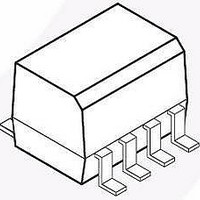FL7930BM Fairchild Semiconductor, FL7930BM Datasheet - Page 15

FL7930BM
Manufacturer Part Number
FL7930BM
Description
Power Factor Correction ICs PFC Controller for Lighting; 2nd OVP
Manufacturer
Fairchild Semiconductor
Datasheet
1.FL7930BM.pdf
(20 pages)
Specifications of FL7930BM
Switching Frequency
300 KHz
Maximum Operating Temperature
+ 125 C
Mounting Style
SMD/SMT
Package / Case
SOP-8
Minimum Operating Temperature
- 40 C
Lead Free Status / Rohs Status
Lead free / RoHS Compliant
© 2011 Fairchild Semiconductor Corporation
FL7930 • Rev. 1.0.0
Unlike a conventional voltage-mode PWM controller,
FL7930 turns on the MOSFET at the falling edge of
ZCD signal. On instance is decided by the external
signal and the turn-on time lasts until the error amplifier
output (V
load is heavy, output voltage decreases, scaled output
decreases, COMP voltage increases to compensate low
output, turn-on time lengthens to give more inductor
turn-on time, and increased inductor current raises the
output voltage. This is how PFC negative feedback
controller regulates output.
The maximum of V
the maximum turn-on time, and switching stops when
V
The roles of PFC controller are regulating output voltage
and input current shaping to increase power factor. Duty
control based on the output voltage should be fast
enough to compensate output voltage dip or overshoot.
For the power factor, however, the control loop must not
react to the fluctuating AC input voltage. These two
requirements conflict; therefore, when designing a
feedback loop, the feedback loop should be least ten
times slower than AC line frequency. That slow
response is made by C1 at compensator. R1 makes
gain boost around operation region and C2 attenuates
gain at higher frequency. Boost gain by R1 helps raise
the response time and improves phase margin.
COMP
is lower than 1.0V.
Figure 37. Turn-On Time Determination
COMP
) and sawtooth waveform meet. When
Figure 36. Control Circuit
COMP
. 0
155
V
is limited to 6.5V, which dictates
/
s
15
For the transconductance error amplifier side, gain
changes based on differential input. When the error is
large, gain is large to force the output dip or peak to
suppress quickly. When the error is small, low gain is
used to improve power factor performance.
8. Soft-Start: When V
reference voltage is increased like a stair step for 5ms.
As a result, V
turn-on time increases smoothly. This reduces voltage
and current stress on the power switch during startup.
V
V
I
REF
g
CC
SOURCE
V
M
COMP
SS
Figure 38. Compensators Gain Curve
COMP
V
START
250
Figure 40. Soft-Start Sequence
Figure 39. Gain Characteristic
COMP
=12V
mho
115
(V
I
SOURCE
is also raised gradually and MOSFET
REF
mho
SS
-V
COMP
5ms
INV
CC
)
R
g
COMP
M
reaches V
=I
SOURCE
V
=V
INV
COMP
=0.4V
COMP
START
V
REF
FL7930 Rev.00
END
, an internal
www.fairchildsemi.com
=2.5V
t












